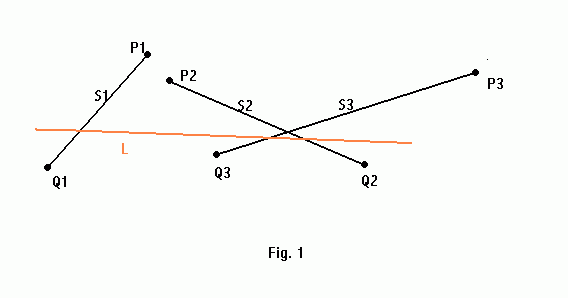
We already know how to find a stabbing line, or a transversal of a line segments set. In this section we'll learn how to compute the shortest such transversal. Note that this topic is rather complicated and could be a subject to a project all by itself. Therefore, here only a simplified version is presented.
Let S = { S1, S2, ..., Sn} be a set of line segments and L be its stabbing line (transversal). We'll assume L is not vertical.
Let a(Si , L) denote the end point of Si which lies above L, and b(Si, L) -- end point which lies below L.

In figure 1, a(S1, L) = P1; b(S2, L) = Q2.
Also, let A(S, L) = { a(S1, L), a(S2, L), ... a(Sn, L) }, and similarly B(S, L) = { b(S1, L), b(S2, L), ... b(Sn, L) }.
In the figure, A(S, L) = {P1, P2, P3}, B(S, L) = {Q1, Q2, Q3}.
We'll call two transversals L1, L2 equivalent if A(S1, L) = A(S2, L).
Definitions:
1) A simple polygon is a kite-shaped if it contains only four convex vertices labeled A, B, C, D such that the diagonals [A, C] and [B, D] lie in the polygon.

Pay attention that AB, BC, CD and DA are concave chains.
2) A line segment Si is left of another line segment Sj with respect to a transversal L, if the intersection of Si with L lies to the left of the intersection of Sj with L.
The right relation is defined in the same manner.
3) Left-envelope of a set of line segments S is defined with respect to an equivalence class of transversals. It's the union of all points P which are the leftmost intersection points of a line segment in S with some transversal belonging to the class.
The right-envelope is defined similarly.
Let CH(A(S, L)) denote the convex hull of the set of points A(S, L), and CH(B(S, L)) -- the convex hull of B(S, L).
Now we are ready to present an algorithm for computing the shortest transversals:
We are given a set S = {S1, S2, ..., Sn} of line segments.
A(S, L(Ri+1 )) = { A(S, L(Ri )) - a(Sk, L(Ri )) } U { b(Sk, L(Ri )) }, and
B(S, L(Ri+1 )) = { B(S, L(Ri )) - b(Sk, L(Ri )) } U { a(Sk, L(Ri )) }.
If Ri and Ri+1 are disjoint, the line segments whose end points switch sides from above or below of L(Ri ) to below or above of L(Ri+1 ) are those whose corresponding double wedge centers lie between regions Ri and Ri+1. Therefore, we can compute the sets A and B for L(Ri+1 ) from those for L(Ri ).
- Compute the left envelope, the right envelope, convex hull of the upper end points of S, convex hull of the lower end points of S.
- Compute the critical lines of support between the two convex hulls and concatenate their relevant portions with the envelopes and convex hull boundaries to obtain a kite-shaped polygon.
- Compute the minimum visible distance between the left and right chains of the polygon.